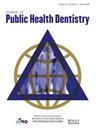Prevalence of non-cavitated lesions and progression, regression, and no change from age 9 to 23 years
Abstract
Objectives
Some non-cavitated caries lesions (D1), the initial stage of caries, progress to cavitation. This article reports participant-level and surface-level D1 prevalence and changes in status of D1 lesions through different periods from age 9 to 23.
Methods
The Iowa Fluoride Study (IFS) participants were followed longitudinally; all permanent tooth surfaces were examined clinically for caries at ages 9, 13, 17, and 23 using standardized criteria for sound (S), questionable (D0), non-cavitated (D1), cavitated (D2+), filled (F), or missing due to decay (M). D1 lesions at the beginning of each interval were reassessed at each follow-up age to determine transitions (to the 5 categories or no transition).
Results
The sample had relatively high socioeconomic status (SES), with about 52%–55% high SES, 32–35% middle SES, and 12–13% low SES. Person-level prevalences of D1 lesions were 23%, 38%, 60%, and 45% at ages 9, 13, 17, and 23, respectively. Surface-level prevalences were less than 1% at ages 9 and 13, 3% at 17, and 2% at 23. Thirteen percent of D1s at age 9 progressed at 13, 18% progressed from 13 to 17, and 11% progressed from 17 to 23. The percentages regressing (to sound or D0) were 72%, 54%, and 72%, respectively.
Conclusion
Non-cavitated lesions were more prevalent at age 17 than at ages 9, 13, and 23. The high rates of regression compared to progression or no change suggest that many non-cavitated lesions do not progress to cavitated lesions and could be reversed; therefore, surgical intervention should not be the treatment of choice for incipient lesions.




 求助内容:
求助内容: 应助结果提醒方式:
应助结果提醒方式:


